
Written by Jason Thompson
 |
| RICHARD LANE / COLLECTION OF CATHERINE LANE POOLE DUPRÉ |
| Edward Lane adopted the dress of an upper-class Ottoman when he made his first visit to Cairo in 1825. He relished the freedom this gave him to explore unobtrusively and to draw what was then still largely a medieval city, portraying such scenes as the entrance to al-Azhar University. |
 ate one September afternoon in 1825, an apprehensive 24-year-old Englishman arrived in the Eastern Harbor of Alexandria, Egypt. “As I approached the shore,” he wrote, “I felt like an Eastern bridegroom, about to lift up the veil of his bride, and to see, for the first time, the features which were to charm, or disappoint, or disgust him.” He continued:
ate one September afternoon in 1825, an apprehensive 24-year-old Englishman arrived in the Eastern Harbor of Alexandria, Egypt. “As I approached the shore,” he wrote, “I felt like an Eastern bridegroom, about to lift up the veil of his bride, and to see, for the first time, the features which were to charm, or disappoint, or disgust him.” He continued:
I was not visiting Egypt merely as a traveller, to examine its pyramids and temples and grottoes, and, after satisfying my curiosity, to quit it for other scenes and other pleasures: I was about to throw myself entirely among strangers; to adopt their language, their customs and their dress; and, in associating almost exclusively with the natives, to prosecute the study of their literature. My feelings therefore, on that occasion, partook too much of anxiety to be very pleasing.
Edward William Lane need not have worried. He would become, one day, Britain’s most renowned scholar of the Middle East. He would write a fascinating study of Egyptian society, a book so definitive and widely read that it would never go out of print; his great Arabic–English dictionary would become a basic, irreplaceable reference work; and his translation of The Arabian Nights would delight and instruct generations of readers. Lane’s name would come to be known throughout the field of Middle Eastern studies, admired by western and Arab scholars alike.
Four years earlier, Lane had been working as an engraver’s apprentice in London. It was a natural enough career choice, for the Lanes were an artistic family. Lane’s great-uncle was the painter Thomas Gainsborough, and one of his elder brothers, Richard J. Lane, became a highly skilled artist. But Lane was not destined to become an engraver. The rediscovery of ancient Egypt in the aftermath of Napoleon’s Egyptian expedition had created a great popular sensation, and enigmatic, stately objects from that antique land filled the British Museum. Fascinating accounts by travelers on the Nile inundated booksellers’ shops. Giovanni Battista Belzoni’s visually stunning exhibit about the tomb of Seti i, which he had recently discovered in the Valley of the Kings, opened not far from where Lane worked. All these things turned the imagination of the apprentice engraver in new directions.
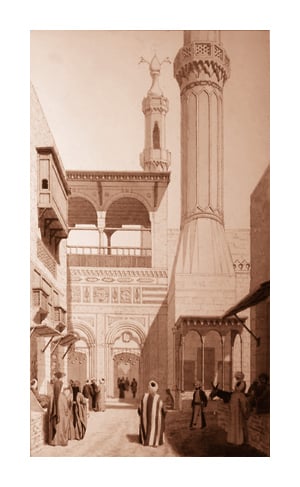 |
| EDWARD WILLIAM LANE, FROM MANNERS AND CUSTOMS OF THE MODERN EGYPTIANS; |
| The entrance to al-Azhar University. |
As he later explained:
A zealous attachment to the study of oriental literature, and a particular desire to render myself familiar with the language of the Arabs, and with their manners and customs, induced me to visit Egypt. But these were not my only motives. I had long entertained a wish to examine the antiquities of that most interesting country: and as I felt, even before I commenced my travels, that there was a probability of my publishing the observations that I might make; I purposed to execute a series of sketches of all the most remarkable objects that I might see; well convinced that a drawing, in many cases, is worth many pages of description. For several years, Lane devoted every spare moment to reading everything he could find about Egypt, ancient and modern, and to learning Arabic. The British politician Lord Bexley, avid amateur scholar and friend of the Lane family, provided the funds for Lane to realize his dream of traveling to Egypt. So it was that Lane arrived in Alexandria that September afternoon in 1825. But he worried as he prepared to set foot on the shore: What would he do after all that preparation if he did not like Egypt after all?
Those initial apprehensions vanished soon after his arrival. Egypt during the early 19th century, though nominally a province of the Ottoman Empire, was under the firm control of its pasha, Muhammad Ali, who ruled the land almost as a sovereign monarch. His hand was sometimes heavy, but he created conditions of almost unprecedented order and security that enabled visitors like Lane to travel through the country at will and observe it at leisure and in safety.

Cairo was then a city of perhaps a quarter of a million people, still thoroughly medieval in customs and appearance, looking much as it had for hundreds of years. Lane found great pleasure walking through its narrow, intricate streets, looking at the people, admiring the profuse specimens of Islamic architecture, and lingering in the shops and coffee houses. He found a house in the northwestern part of town, far from the quarters inhabited by Europeans—Franks, they were called. Casting off his Frankish attire, he dressed only in Egyptian clothing when he was in Egypt and conformed to Egyptian manners. Within a year his Arabic was fluent.
He even adopted an Eastern persona, becoming known as Mansur Effendi, a name engraved on the signet ring he wore on the small finger of his right hand until the end of his life.
“I have associated, almost exclusively, with Muslims, of various ranks in society,” he wrote. “I have lived as they live.” That provided the perspective for the close observations of Egyptian society and language that proved essential for his work, but it was more than just a convenient pose. As the Egyptian scholar Leila Ahmed wrote, “Lane loved Egypt, unreservedly loved almost everything about it. From his arrival, his entire life and the work he undertook would be an act of devotion and service to this country and culture that he so much loved and in which he felt, almost from the start, more at home than he did in his own land.”
 |
| EDWARD WILLIAM LANE, FROM DESCRIPTION OF EGYPT |
Lane included himself (seated, far left) in this scene near the entrance of Cairo’s Khan al-Khalili bazaar.
He depicts sakkas (water carriers) accompanying a caravan, one afoot, the other steadying the waterskin
on a donkey. |
Although Lane did indeed associate almost exclusively with Muslim Egyptians, he was also part of a small circle of young European Egyptologists and orientalists who were present in Egypt during the 1820’s and who aided each other in their research. This circle included such people as Sir Gardner Wilkinson, the founder of Egyptology in Britain, Robert Hay, Joseph Bonomi, James Burton, Frederick Catherwood and the future Duke of Northumberland. Some of them are little remembered now, but their work is of great importance to scholars in many different specialties. Like Lane, they adopted eastern lifestyles and identities in Egypt: Wilkinson, for example, was known as Ismail; Bonomi took the playful name Abu Nom. All wore Egyptian clothing. Lane was now immersed in his studies of Arabic and contemporary Egyptian culture, but he retained a lively interest in ancient Egypt and made it a major part of his first book. “Never did I spend a more happy time,” he wrote of the days he passed living in a tomb while he worked at the Pyramids of Giza. With some knowledge of the recently deciphered hieroglyphs, he was able to identify many ancient monuments with much greater certainty than before. His notes and drawings for places and objects that were damaged or destroyed in subsequent years have permanent Egyptological value. Had his first book, Description of Egypt, been published during his lifetime, Lane would be remembered as a pioneering Egyptologist as well as a distinguished orientalist.
During his first trip to Egypt, Lane twice ascended the Nile through Upper Egypt and Egyptian Nubia (the latter now submerged by Lake Nasser) to the Second Cataract at Wadi Halfa, traveling by dahabiyeh, the conveyance of choice for generations of Nile voyagers. From the comfortable cabin at the back of this sleek river boat, with its elegant triangular sail, he could watch the panorama of Egypt roll past, stopping and studying the great archeological sites. From his copious notebooks and sketches, preserved in British archives, we can follow his progress all along the way. By the time Lane left Egypt in April 1828, after a year and a half in Cairo and about as much time upcountry, he had plenty of material for his intended book.
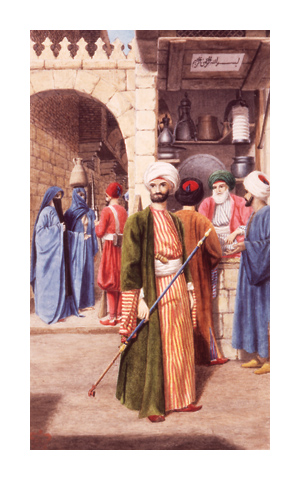 |
| EDWARD WILLIAM LANE, FROM DESCRIPTION OF EGYPT |
| Lane’s focus from his earliest moments in Egypt was on its people. This colorful Cairo street scene shows an upper-class man in front of a busy copperware shop. Under the arch, a soldier of Muhammad Ali’s army stands before two Egyptian women. |
Lane was not alone when he departed from Egypt, however: He was accompanied by a little girl named Nefeeseh whom either he or his friend Robert Hay purchased in the Cairo slave market. Perhaps eight years old, she had been taken captive during the turmoil of the Greek War of Independence (1821–1826) and brought to Cairo for sale. Family tradition holds that Lane passed the slave market one evening and saw her standing in the shadows, pitiful and alone, and was moved by compassion to buy her. But his papers suggest that Robert Hay purchased her—a more likely story because Lane could have ill afforded a Greek female slave, the most expensive kind of all. However it happened, Nefeeseh passed into Lane’s care. He took her to England to be raised by his mother. Years later, when Nefeeseh was a grown woman, she and Lane married. They enjoyed a good, companionable marriage of 35 years until parted by Lane’s death. “Never, I believe, has there existed a more affectionate wife,” Lane confided to Hay.
Like some travelers, Lane found that the worst jolt of culture shock came not from going to the Middle East but from returning home. After becoming used to sitting on divans, carpets and cushions, English furniture was hard to bear. “I cannot endure these chairs,” he whispered to an acquaintance one night at a dinner party. “I will tuck my legs under me and then I shall be comfortable.” He became known in society as “Egyptian” Lane. Problems of readjustment did not prevent Lane from starting immediately to write Description of Egypt, a remarkable work that ranged across nearly the entire field of Egyptian studies. Loosely set within the framework of his travels and personal experiences, it included such subjects as ancient, medieval and modern Egyptian history; it contained a detailed overview of the geography and produce of the land, close descriptions of the city of Cairo, an itinerary of the towns and ancient monuments in the valley of the Nile and much more. The first draft also included chapters about the “manners and customs of the modern Egyptians,” an examination of contemporary Egyptian society far deeper and more accurate than anything written about it before.
 When he had finished about one-third of the book, Lane took the manuscript and preliminary sketches for its illustrations to the eminent publishing firm of John Murray in London’s Albemarle Street. This was aiming high, for Murray’s was the publisher not only of literary luminaries like Lord Byron but also of the great explorers and travelers of the Middle East: J. L. Burckhardt, the great Belzoni and dozens of others. But Lane had apparently judged correctly, for John Murray ii, then head of the firm, was impressed with what he saw, and so was the expert he consulted about it. In their considered opinion, it was “the best work which has been written on the subject.” As for the drawings, Murray exclaimed that they were the most accurate he had ever seen: “the more the work contained of them, the better.”
When he had finished about one-third of the book, Lane took the manuscript and preliminary sketches for its illustrations to the eminent publishing firm of John Murray in London’s Albemarle Street. This was aiming high, for Murray’s was the publisher not only of literary luminaries like Lord Byron but also of the great explorers and travelers of the Middle East: J. L. Burckhardt, the great Belzoni and dozens of others. But Lane had apparently judged correctly, for John Murray ii, then head of the firm, was impressed with what he saw, and so was the expert he consulted about it. In their considered opinion, it was “the best work which has been written on the subject.” As for the drawings, Murray exclaimed that they were the most accurate he had ever seen: “the more the work contained of them, the better.”
There was just one problem. Murray liked the “manners and customs of the modern Egyptians” section but thought it did not fit into the overall work and insisted that it be removed. Lane agreed only with great reluctance, but once that issue was settled, Murray agreed to publish the book. He told Lane to finish writing it and to work up the illustrations to a highly finished state so they could be reproduced by the finest means possible, whether by engraving, lithography (Lane’s preferred method) or woodcuts.
Elated by Murray’s acceptance, Lane set to work and produced a large manuscript of nearly 300,000 words, written in his beautifully clear hand. He also prepared approximately 200 illustrations. All are clearly done, and the best should rank at least as minor works of art, but Lane’s primary objective was always to convey as much information as possible in each picture and with the utmost accuracy. His illustrations, as he later stated, were made “not to embellish the pages, but merely to explain the text.”
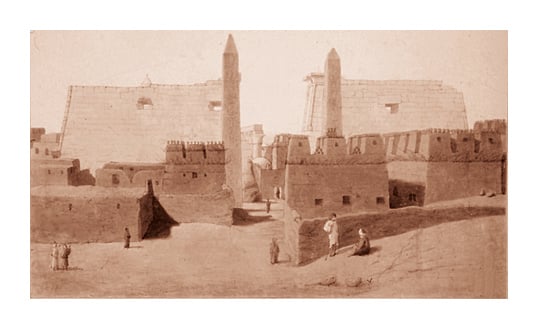 |
| EDWARD WILLIAM LANE, FROM DESCRIPTION OF EGYPT |
| When Lane first viewed Luxor Temple in Upper Egypt in 1826, the village of Luxor had spread into it, and the obelisk at the right had not yet been taken to Paris, where it stands today. |
But just as he finished all that work, Britain was seized by the extended political crisis that culminated in the Reform Bill of 1832. Trade was paralyzed; only books about politics were selling. Murray decided it was prudent to postpone publication of Description of Egypt.
As the delay became ever more protracted, Lane sank into depression. He longed to see his work in print, and he needed the money he thought he would make from it. He also missed Egypt painfully. He had been happy there: Every moment was meaningful, each day brought new experiences, the future was full of possibilities. “Think what I would give for one week again at Thebes, & how I should employ it!” he wrote to Robert Hay, who was still in Egypt. “I wish I were in your place.” He longed to return, but he had no money.
Then Lane remembered the “manners and customs of the modern Egyptians” section he had removed from Description of Egypt at Murray’s insistence. He took it to a remarkable 19th-century institution known as the Society for the Diffusion of Useful Knowledge, which existed for the stated purpose of “imparting useful information to all classes of the community.” The SDUK decided that Lane’s book would indeed be useful and paid him an advance to go back to Egypt and gather additional material for it. That enabled Lane to sail on his second trip to Egypt at the end of 1833.
Once again Lane threw himself into Egyptian life as he examined its nuances more carefully than ever, recording them meticulously in word and picture, as his many surviving diaries, workbooks and letters attest. Working with characteristic speed and energy, he finished the book in exactly one year and was preparing to return to England when a devastating epidemic of bubonic plague exploded in Alexandria and spread to Cairo. Lane fled in the opposite direction, south to Thebes, where he spent several more months living in one of the Tombs of the Nobles on the west bank that his friend Gardner Wilkinson had remodeled into a comfortable house. We might look askance today at risking spreading the disease by traveling on a rat-infested boat, but Lane’s prompt action may well have saved his life, for the Great Plague of 1835 killed one-third of Cairo’s population.
 An Account of the Manners and Customs of the Modern Egyptians was published in December 1836. It was an instant success, selling out its first printing within a matter of weeks and subsequently going through numerous editions and reprints, right down to the present day. Acclaimed during the 19th century as “the most perfect picture of a people’s life that has ever been written,” Manners and Customs exerted an extraordinary influence that has only grown stronger with time. As Edward Said wrote in his controversial book Orientalism in 1978, the book became “an authority whose use was an imperative for anyone writing or thinking about the Orient, not just about Egypt.”
An Account of the Manners and Customs of the Modern Egyptians was published in December 1836. It was an instant success, selling out its first printing within a matter of weeks and subsequently going through numerous editions and reprints, right down to the present day. Acclaimed during the 19th century as “the most perfect picture of a people’s life that has ever been written,” Manners and Customs exerted an extraordinary influence that has only grown stronger with time. As Edward Said wrote in his controversial book Orientalism in 1978, the book became “an authority whose use was an imperative for anyone writing or thinking about the Orient, not just about Egypt.”
But Lane’s elation over the success of Manners and Customs was short-lived, for a few days after its appearance, the firm of John Murray, under new management, abruptly cancelled its agreement to publish Description of Egypt, the book that Lane cared about even more. And while Murray’s had waited, the book market had changed. Big, illustrated, expensive books like Description of Egypt had become risky financial ventures, and indeed Lane was never able to find another publisher. Although his attention turned to other things, he regretted his failure to publish his first and favorite book for the rest of his life. Not until the year 2000, a century and a quarter after his death, was Description of Egypt published.
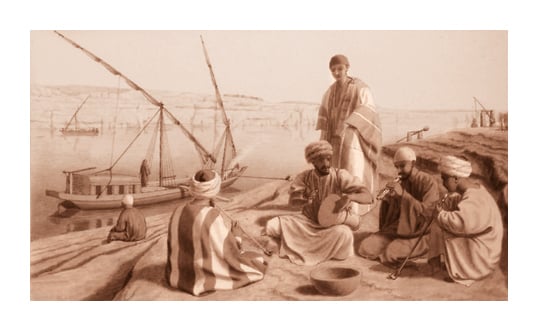 |
| EDWARD WILLIAM LANE, FROM DESCRIPTION OF EGYPT |
| Lane twice ascended the Nile as far as the Second Cataract. This drawing of his boat (dahabiyeh) and its crew is typical of his illustrations: It attempts to convey as much information as possible, including details of the boat, the crew’s clothing, their musical instruments—and even shadufs, the water-raising device in the background, right. |
Lane’s dismay was somewhat assuaged by a consuming new project, a translation of The Thousand and One Nights. Lane had long been interested in this classic work, also known as The Arabian Nights, because he thought it presented “most admirable pictures of the manners and customs of the Arabs, and particularly of those of the Egyptians.” That such fantastic tales, redolent with magic and improbable coincidences, should be taken as a reliable guide to Arab and Egyptian society might seem strange, but Lane clearly understood something very important about The Arabian Nights: A jinn might not really be held captive in a bottle for centuries, but the descriptions of that bottle—its shape, its design, its stopper—might all be drawn accurately from real life. So, too, with many other details like manners, political organization, religious practices and material culture, all of which are to be found in profusion in the pages of The Arabian Nights. It was precisely those details that Lane wanted to present, with explanations, to an English readership.
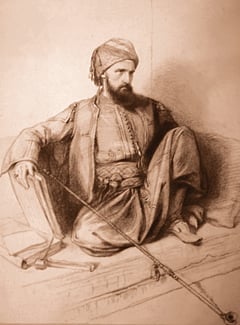 |
| RICHARD LANE / COLLECTION OF CATHERINE LANE POOLE DUPRÉ |
| This portrait of Lane dates from 1835, after his second trip to Egypt, during which he wrote Manners and Customs of the Modern Egyptians. |
Lane’s translation of The Arabian Nights appeared in monthly installments between 1838 and 1840 and was then published complete in three volumes. Highly readable and thoroughly enjoyable, it reigned supreme as the leading English translation for most of the 19th century. Although it was eventually displaced from its preeminent position by other translations, Lane’s has its partisans even today, for there is still no one translation of The Arabian Nights that can be considered definitive. One of the beauties of Lane’s translation is its 650 illustrations, executed by some of Britain’s leading wood engravers under Lane’s careful supervision and well worth perusing for their own sake. Preparation of The Arabian Nights was a great achievement, but also a relentless ordeal that forced Lane to write prodigiously—besides correcting proofs for both words and pictures—month after month for three years. But the end of the task brought no relief: First, his mother, the most important formative influence in his life, died. Then the publisher of The Arabian Nights went bankrupt before paying him in full. Having just married Nefeeseh, Lane needed money more than ever. Yet he was not sure what his next major project would be or how he could make it pay. In 1841, at age 40, Lane was experiencing an authentic midlife crisis.
At that crucial moment his old friend the Duke of Northumberland came to his aid. The duke offered to support Lane in the preparation of a definitive Arabic–English dictionary. For Lane, who had once written how he had been possessed, as a young man, by “a zealous attachment to the study of oriental literature, and a particular desire to render myself familiar with the language of the Arabs,” this was the consummation of a relationship that had been developing all his life. Financed by the duke, Lane prepared to return to Egypt to gather the classical Arabic lexicographical texts that would form the basis of his dictionary.

Nothing existed like the dictionary he planned. The standard works were the 17th-century Arabic–Latin dictionaries of Franciscus Raphelengius and Jacob Golius. Magnificent accomplishments in their time, they had long fallen out of date, being limited in sources, deficient in organization and scope, and marred by mistakes. Georg Freytag’s Lexicon Arabico–Latinum, published during the 1830’s, did little more than replicate the shortcomings of its predecessors. And all of those dictionaries were composed in Latin, a language that was not only already slipping into decreasing scholarly use but was also unsuitable for treating Arabic. As Lane told the Duke of Northumberland, “There are thousands of Arabic words & phrases which Cicero himself could not have expressed” in Latin. It was high time for a dictionary of Arabic and a major modern European language. Lane set about single-handedly to fill that need.
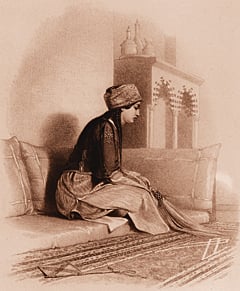 |
| RICHARD LANE / COLLECTION OF CATHERINE LANE POOLE DUPRÉ |
| This portrait has sometimes been identified as Edward Lane’s Greek-born wife Nefeeseh, whom—according to family tradition—he found in a Cairo slave market, purchased and later married. (In fact, Lane’s friend Robert Hay was probably the principal in the transaction.) More probably, however, the portrait is a study by Lane’s brother Richard of an unidentified young Egyptian woman, made from a sketch by Lane. Nonetheless, Nafeeseh would have dressed much like this in Cairo. |
Lane sailed on his third trip to Egypt in July 1842, accompanied by Nefeeseh and by his sister, Sophia Poole, and her two sons, Stanley and Stuart. The Lanes were always a close family, and Sophia had been deserted by her husband, so Lane was glad to have her with him. He and Nefeeseh never had children, so he had come to think of Stanley and Stuart as his own. But he also hoped Sophia would write about her experiences in Egypt. Although his Manners and Customs had been praised for its completeness, Lane knew that its descriptions of women were superficial: He had been unable to interview Egyptian women and had had to draw almost all of his information about them from Egyptian men. Sophia, however, could go places he had not, and would be able to write about Egyptian women in much more depth—and her resulting book would also help pay the bills. This third and longest trip was far different from the preceding ones. Before, Lane had been much in society and traveled extensively through the country. This time he remained at home, sometimes not going out of doors for months on end, working steadily at his overwhelming task, assisted only by Sheikh Ibrahim al-Dasuqi, his Arabic language assistant. Al-Dasuqi helped Lane with copying and could discuss fine points of Arabic grammar and spelling. Every once in a while, for a change of pace, they played Arabic word games together, but Lane’s focus never strayed far from his dictionary.
Meanwhile, Sophia worked on her book, aided by Lane, who sometimes supplied material and always offered suggestions. He reviewed and approved each chapter when she finished it. Covered from head to ground in her black habarah, her face concealed by a long, heavy veil, Sophia would ride forth on her donkey, accompanied by servants, to visit the harems of the great, including that of the Pasha of Egypt, the powerful Muhammad Ali, where she always received a warm welcome. These occasions, as she explained, provided “frequent and familiar intercourse with the ladies of the higher and middle classes … such as, I believe, few Englishwomen have enjoyed.”
Sophia’s book, The Englishwoman in Egypt, was received enthusiastically in Britain when it appeared in three volumes between 1844 and 1846. “Mrs. Poole has now done for Egypt what Lady Mary Wortley Montague did for Turkey,” one reviewer wrote, comparing Sophia to the great 18th-century ethnographer of Turkish women and society, “and even more, as her relationship to Mr. Lane, the celebrated Arabic scholar, and long a resident in Egypt, has enabled her to supply information on subjects not generally to be expected from female travelers.” Even so, Sophia did not go nearly as far as Lane might have wished, for, as she openly admitted, she could never sufficiently overcome her own social and religious prejudices to present a full picture of women’s life in Egypt. Nevertheless, The Englishwoman in Egypt became one of the classic studies of 19-century Egyptian women.
 |
| RICHARD LANE / COLLECTION OF CATHERINE LANE POOLE DUPRÉ |
| Lane’s sister, Sophia Poole, accompanied him on his third trip, during which she wrote The Englishwoman in Egypt. |
The Lanes and Pooles returned to England in 1849 and settled in Worthing, a quiet town on the southern coast. Lane left it just once, and then only to travel to nearby Brighton to visit a dying friend. At Worthing, he maintained the tightly focused lifestyle he had developed in Egypt, beginning each working day early by saying the bismillah, the opening lines of the Qur’an—“In the name of God, the compassionate, the merciful”—and working until 10 at night, stopping only for meals and an afternoon walk in the nearby countryside when the weather was fine. Every Friday he put his lexicographical work aside to spend time with his family and perhaps receive a few close friends, but most other callers, no matter how distinguished, were politely but firmly refused by his wife and sister, who closely guarded his precious time. Every Sunday was reserved for studying the Bible, which he read in Hebrew.
The first of the eight volumes of Lane’s Arabic–English Lexicon were published in 1863 and the work’s importance was immediately recognized. Even the London Times took notice: “Of the manner in which Mr. Lane has performed his work it is difficult to speak in terms of too high praise. It displays all the photographic accuracy for which he is so well known, combined with scholarship of a kind—acquired as it was in the East—which is hard to attain. His familiarity with Eastern minds and habits of thought, and with all the objects of Eastern life, give him an uncommon insight into the meaning and intention of an Arab writer…. It is not too much to say that the work, when completed, will do more to advance the study of Arabic than any other which has appeared during this century.”
Working with his incredible industry and persistence, Lane published the succeeding volumes of the Arabic–English Lexicon at roughly two-year intervals, but it was all too apparent that he was racing against time and death.
He finished writing the fourth volume, covering the letters , , and , in 1870, but on the very day it was printed, all but one copy was destroyed by fire. Two years were lost. Lane was 68 years old and in frail health. His response was to increase his efforts, focusing even more tightly than ever on the Lexicon. But composition, printing and proofing could only go so fast. Lane was working on the article for volume six on August 5, 1876 when he was taken ill; he died five days later. The Lexicon’s final three volumes were published under the supervision of his great-nephew, Stanley Lane-Poole, who later made a name for himself in Arab numismatics, among other areas.

 |
| COLLECTION OF CATHERINE LANE POOLE DUPRÉ (2) |
| This photographic portrait of Lane was made in 1863, the year the first of his Arabic–English Lexicon’s eight volumes was published. To this day, the Lexicon remains indispensable to scholars. |
Edward William Lane’s Arabic–English Lexicon is still an indispensable reference tool for the classical Arabic language. Of the many scholarly accolades it has received over the decades, the one by the great Cambridge orientalist A. J. Arberry in 1960 is representative: “Every Arabist since Lane has had good cause to bless him for his superhuman labours, and to regret that he had not begun his project earlier in life, so that there might have been a greater chance of its completion. It is certainly true to say, that every work produced in this century relating in any way to Arabic studies has drawn heavily upon the Lexicon. It is a sufficient tribute to its unique greatness, that to this day it remains supreme in the field of Arabic lexicography: no scholar or group of scholars has produced anything to supplant it.”
That evaluation holds true in the 21st century. Professor Manfred Woidich of the University of Amsterdam describes Lane’s Lexicon as “a fine combination of eastern and western scholarship. For the scholar busy with classical Arabic, it is an indispensable working tool which will not be replaced in years to come.”
Lane is buried in London’s West Norwood Cemetery, not far from the graves of his acquaintances, the artists David Roberts, who sought Lane’s advice before making his epochal trip to Egypt, and the less renowned but highly gifted Louis Haghe, whose fine hand reproduced the works of many of his more famous fellows, including Roberts, for publication. Lane had once hoped Haghe would prepare the finished prints for Description of Egypt.
But one should not visit West Norwood to see Lane’s grave monument, because the local government, not knowing or caring who he was, smashed it and carted away the pieces some years ago, laboring under some misguided idea about clearing space. Yet all of Lane’s major books—Description of Egypt, Manners and Customs of the Modern Egyptians, The Thousand and One Nights, and the Arabic–English Lexicon—are in print at this moment, monuments more enduring than stone to a modest man and his zealous attachment to the study of Arabic literature.
Publication of the Description of Egypt
 lthough Manners and Customs of the Modern Egyptians made Lane famous as an orientalist, the book he cared about most was Description of Egypt, the reason for his first trip there in 1825. After accumulating a large collection of notebooks and sketches,
lthough Manners and Customs of the Modern Egyptians made Lane famous as an orientalist, the book he cared about most was Description of Egypt, the reason for his first trip there in 1825. After accumulating a large collection of notebooks and sketches, 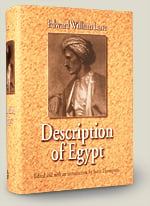 Lane returned to England, revised the manuscript of Description of Egypt through three drafts and brought the illustrations to a high state of readiness, only to be prevented from going to press by a prolonged series of setbacks. This was a bitter disappointment, and Lane continued to hope for the rest of his life that some way might be found to publish the book—but always in vain. After his death, the notes, pictures and manuscript drafts of Description of Egypt were scattered to various British collections.
Lane returned to England, revised the manuscript of Description of Egypt through three drafts and brought the illustrations to a high state of readiness, only to be prevented from going to press by a prolonged series of setbacks. This was a bitter disappointment, and Lane continued to hope for the rest of his life that some way might be found to publish the book—but always in vain. After his death, the notes, pictures and manuscript drafts of Description of Egypt were scattered to various British collections.
During the 1990’s, Jason Thompson, an expert on British scholars, artists and travelers in the Middle East, began working through Lane’s papers and painstakingly reconstructed a definitive edition of Description of Egypt.
For a long time, however, it looked as though Thompson’s attempt to resuscitate Lane’s first book would merely reprise Lane’s futile efforts: Publisher after publisher turned it down as commercially unviable. But Mark Linz and Pauline Wickham, the director and senior editor of the American University in Cairo Press, immediately saw the book’s potential. “Our reaction was tremendous excitement,” Linz said. “We knew this was an important book and that Jason Thompson was the only person who could handle it.” In 2000, nearly 170 years after Description of Egypt was originally intended to be printed, the American University in Cairo Press published a complete, fully illustrated edition of it. The confidence that Thompson, Linz and Wickham placed in Edward William Lane’s previously unpublished book turned out to be justified: Description of Egypt will soon enter its third printing.
Europeans in Egyptian Dress
 ost European travelers in Egypt during Lane’s day adopted Egyptian dress in the hope of passing unnoticed as foreigners. Usually they lived and dressed not as native Egyptians, for whom they could never hope to be mistaken, but as members of Egypt’s Ottoman Turkish elite, who were accepted as an integral, if privileged, part of Egyptian society. That provided the additional advantage of ensuring a degree of deference from the general population. As Lane wrote in his Description of Egypt:
ost European travelers in Egypt during Lane’s day adopted Egyptian dress in the hope of passing unnoticed as foreigners. Usually they lived and dressed not as native Egyptians, for whom they could never hope to be mistaken, but as members of Egypt’s Ottoman Turkish elite, who were accepted as an integral, if privileged, part of Egyptian society. That provided the additional advantage of ensuring a degree of deference from the general population. As Lane wrote in his Description of Egypt:
If dressed in the European style, he [the traveler] is seldom molested or insulted: but if habited as a Turk, he commands respect, & as he passes the peasant employed in the labours of agriculture, or driving his loaded ass or camel, or riding from one town or village to another, he gives, or returns, the salutation of peace.
One influential traveler whose example Lane followed in Egypt was Johann Ludwig Burckhardt, the famous Swiss explorer and Arabist who discovered Petra and Abu Simbel. “I wonder whether you would recognize me if you could see me now,” Burckhardt wrote to his parents in Switzerland. Burckhardt’s clothing is commemorated on his tomb in Cairo’s Bab al-Nasr Cemetery; a full set of Lane’s Egyptian clothing is preserved in Oxford’s Ashmolean Museum.
 |
Historian and writer Jason Thompson (jasthomp@gmail.com) has published extensively about the development of Egyptology, classical studies and orientalism in the 19th century. His new book, Edward William Lane: A Biography, is in press. |